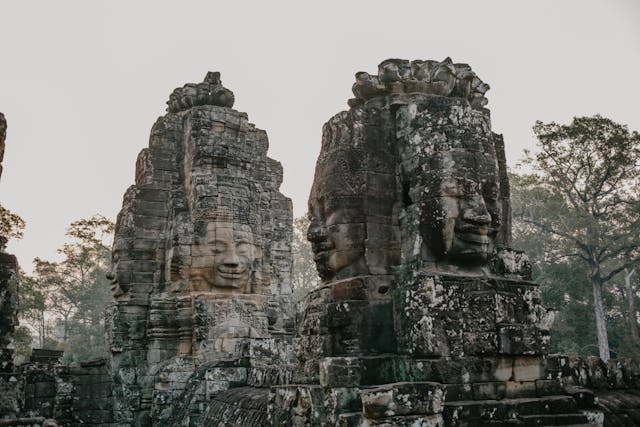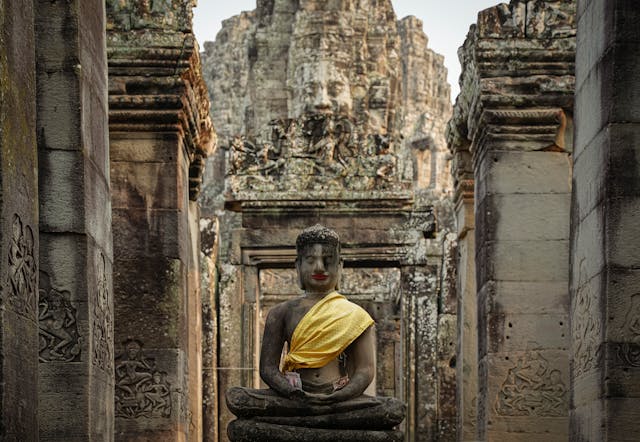Traveling in Vietnam and Cambodia offers distinct experiences, each filled with unique culture, history, and landscapes. While both countries are located in Southeast Asia and share some similarities, such as a rich history and stunning natural beauty, there are also significant differences in their travel environments, making them each special in their own right.
Here’s a detailed comparison of traveling in Vietnam and Cambodia.
1. History and Culture
Both Vietnam and Cambodia boast rich, fascinating histories, but they differ in their cultural backgrounds and historical experiences.
-
Vietnam: Known for its vibrant culture, Vietnam has a long history that includes influences from China, France, and its indigenous cultures. The country is famous for its war history, particularly the Vietnam War, which significantly shaped its modern identity. Ancient temples like the Temple of Literature in Hanoi and French colonial buildings in cities like Ho Chi Minh City add to its historical diversity. Vietnamese culture emphasizes family, respect for elders, and a rich tradition of culinary arts, art, and music.
-
Cambodia: Cambodia’s history is deeply rooted in the Khmer Empire, which thrived between the 9th and 15th centuries. One of the main attractions in Cambodia is the Angkor Wat temple complex, a UNESCO World Heritage site and the largest religious monument in the world. The country also has a tragic history due to the Khmer Rouge regime in the 1970s, and visitors can learn about this dark period at places like the Tuol Sleng Genocide Museum in Phnom Penh. Cambodia’s culture is largely shaped by its Buddhist heritage, with many temples, festivals, and cultural practices honoring this faith.
2. Natural Beauty
When it comes to natural landscapes, both countries offer breathtaking scenery, but in different forms.
-
Vietnam: Vietnam is known for its diverse landscapes, from the lush terraced rice fields in Sapa in the north to the stunning beaches in the central and southern regions. Halong Bay, with its limestone karsts, is one of the most famous natural wonders. The Mekong Delta, with its winding rivers and floating markets, is another highlight. Vietnam’s topography is incredibly varied, offering a range of outdoor activities such as hiking, trekking, beach vacations, and cruises.
-
Cambodia: Cambodia’s natural beauty is often overshadowed by its historical sites, but it still offers stunning landscapes. The country is home to the Tonle Sap Lake, the largest freshwater lake in Southeast Asia, surrounded by floating villages and bird sanctuaries. Cambodia also has a coastline with beautiful beaches, particularly around Sihanoukville and the nearby islands like Koh Rong. The country’s countryside offers peaceful rural scenes with rice paddies, palm trees, and small villages.
3. Cost of Travel
For budget travelers, Vietnam and Cambodia both offer affordable travel experiences, but Cambodia is often considered the cheaper destination.
-
Vietnam: Vietnam is generally inexpensive for tourists, with street food meals costing as little as $1 to $3 and budget accommodations priced around $10 to $20 per night. However, popular tourist areas like Hanoi, Ho Chi Minh City, and Halong Bay can be a little more expensive, particularly for higher-end accommodations or activities like guided tours.
-
Cambodia: Cambodia is often considered slightly more affordable than Vietnam, particularly in terms of accommodation and food. Street food in Cambodia is also very cheap, with meals available for as little as $1 or $2. Accommodation in Cambodia can be found for as low as $5 to $15 per night, especially outside the major tourist hubs. Tourist sites, including the Angkor temples, have entrance fees that can add up, but overall, Cambodia offers great value for money.

4. Cuisine
Both Vietnam and Cambodia have rich culinary traditions, but they differ in their flavors and food culture.
-
Vietnam: Vietnamese cuisine is known for its freshness, balance, and complexity. The country’s food is based on the principles of five flavors: sour, bitter, sweet, salty, and umami. Pho (noodle soup), banh mi (sandwiches), and spring rolls are popular dishes. The street food culture is vibrant, and visitors can enjoy delicious dishes like bun cha, com tam, and a variety of fresh seafood. Food is often served with a variety of herbs, fresh vegetables, and dipping sauces.
-
Cambodia: Cambodian cuisine is less globally famous than Vietnamese food but still offers an interesting array of flavors. Rice and noodles are staple ingredients, and the food is often served with a rich variety of herbs and spices. Some notable dishes include amok (a coconut milk-based curry), kuy teav (noodle soup), and prahok (fermented fish paste). Cambodian cuisine can sometimes be more pungent due to the use of fermented fish and shrimp paste.
5. Transportation
Both Vietnam and Cambodia have well-established transportation systems, but there are some differences in ease of travel.
-
Vietnam: Vietnam’s transportation options are varied and easy to navigate, particularly in large cities. Buses and trains connect cities like Hanoi, Ho Chi Minh City, and Da Nang. The country also has an extensive network of domestic flights for faster travel between major destinations. In cities, taxis and motorbikes are the most common way to get around, and rideshare apps like Grab are widely available. The roads can be crowded, so traveling by train or bus between cities can be a more comfortable option.
-
Cambodia: Cambodia’s transportation system is less developed than Vietnam’s, but it’s still possible to get around fairly easily. Bus services are available between major cities, and there are some internal flights. However, Cambodia’s roads, particularly outside the capital Phnom Penh, can be less developed. Tuk-tuks and motos are popular for short trips within cities, and the roads can be slower and less predictable than in Vietnam. Traveling by boat is also popular in Cambodia, especially in areas like Tonle Sap Lake.
6. Tourist Infrastructure
When it comes to tourism infrastructure, Vietnam has a more developed and extensive system in place, while Cambodia is still catching up, though it has made significant improvements.
-
Vietnam: Vietnam is one of the most popular destinations in Southeast Asia, and the tourism infrastructure is well-developed. From luxurious hotels and resorts to budget guesthouses, Vietnam has accommodation options for all budgets. The country also has a wide variety of activities, ranging from cultural experiences to adventure tourism, and the infrastructure to support it. Organized tours, guides, and services are readily available.
-
Cambodia: Cambodia’s tourism infrastructure is more basic but still growing. While Siem Reap (home to the Angkor temples) has a range of accommodations and tour services, other parts of the country may offer fewer amenities. However, Cambodia’s tourism industry is rapidly expanding, with more hotels, restaurants, and activities becoming available.
Conclusion
Traveling in Vietnam and Cambodia offers two fascinating experiences. Vietnam is ideal for those looking for a variety of landscapes, a rich history, and a well-developed tourism infrastructure. Cambodia, while still developing, offers unique cultural experiences, particularly through its ancient temples and stunning natural beauty. Both countries offer affordability, beautiful landscapes, and rich histories, but each provides something unique depending on what kind of experience you’re seeking.
Whether you prefer the hustle and bustle of Vietnamese cities or the serenity of Cambodia’s ancient wonders, both countries offer unforgettable travel opportunities.
Featured Image: The Bayon Temple in Cambodia | Photo by Neat Chanmanith

